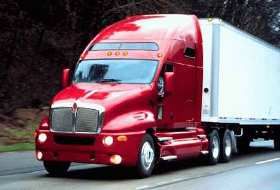Pay For Hours Vs Pay For Miles
Topic 10247 | Page 1

Its 11 hours of drive time within 14 hours of work... So you can drive for 11 hours of that 14 then take a 10 hour break and start driving for 11 of 14... Now when you are waiting to get loaded/unloaded some companies pay a detention pay for waiting but that time does count against your 14 hours... There's a section in the High Road Training Program for the hours of service that explains it better... Check out that link...
CDL:
Commercial Driver's License (CDL)
A CDL is required to drive any of the following vehicles:
- Any combination of vehicles with a gross combined weight rating (GCWR) of 26,001 or more pounds, providing the gross vehicle weight rating (GVWR) of the vehicle being towed is in excess of 10,000 pounds.
- Any single vehicle with a GVWR of 26,001 or more pounds, or any such vehicle towing another not in excess of 10,000 pounds.
- Any vehicle, regardless of size, designed to transport 16 or more persons, including the driver.
- Any vehicle required by federal regulations to be placarded while transporting hazardous materials.

11 hours drive time, 14 hours on duty.
Yes, being on duty and not getting paid is the nature of the beast, nothing to really explain about it. It's why some drivers refer to OTR as having "too much free trucking."
It's a lifestyle. You can't think of it as an hourly gig. Some companies offer detention pay to offset the downtime, but it's not meant as a substitute for how you really earn your money, which is by the miles.
OTR:
Over The Road
OTR driving normally means you'll be hauling freight to various customers throughout your company's hauling region. It often entails being gone from home for two to three weeks at a time.

First of all, when paying cpm , a driver is allowed 11 hours driving in a 14 hour period. When a driver is in a dock, the driver would only record (depending on company policy) about 15 minutes on duty time (for paper logs).
Now drivers that are paid by the hour, the same rules apply, but they are paid by the hour and will probably operate on *12 hours total of driving and dock time, if it's an LTL.
Some companies pay for "dock time," depending on how long you are waiting. Some companies pay after one hour wait time, most pay after two, and others are four hours.
* - I am basing it on one LTL company, others who are LTL drivers may operate differently.
Dave
LTL:
Less Than Truckload
Refers to carriers that make a lot of smaller pickups and deliveries for multiple customers as opposed to hauling one big load of freight for one customer. This type of hauling is normally done by companies with terminals scattered throughout the country where freight is sorted before being moved on to its destination.
LTL carriers include:
- FedEx Freight
- Con-way
- YRC Freight
- UPS
- Old Dominion
- Estes
- Yellow-Roadway
- ABF Freight
- R+L Carrier
CPM:
Cents Per Mile
Drivers are often paid by the mile and it's given in cents per mile, or cpm.

First of all, when paying cpm , a driver is allowed 11 hours driving in a 14 hour period. When a driver is in a dock, the driver would only record (depending on company policy) about 15 minutes on duty time (for paper logs).
Now drivers that are paid by the hour, the same rules apply, but they are paid by the hour and will probably operate on *12 hours total of driving and dock time, if it's an LTL.
Some companies pay for "dock time," depending on how long you are waiting. Some companies pay after one hour wait time, most pay after two, and others are four hours.
* - I am basing it on one LTL company, others who are LTL drivers may operate differently.
Dave
In regard to LTL, it really depends on whether the driver is P&D or linehaul. Some HOS rules don't apply for the city guys that operate within 100 or so miles of the terminal. They are also hourly.
As a linehaul driver, whenever I occasionally help with city work, I clock in and am paid hourly, but still operate under the HOS rules to apply to linehaul.
Terminal:
A facility where trucking companies operate out of, or their "home base" if you will. A lot of major companies have multiple terminals around the country which usually consist of the main office building, a drop lot for trailers, and sometimes a repair shop and wash facilities.
LTL:
Less Than Truckload
Refers to carriers that make a lot of smaller pickups and deliveries for multiple customers as opposed to hauling one big load of freight for one customer. This type of hauling is normally done by companies with terminals scattered throughout the country where freight is sorted before being moved on to its destination.
LTL carriers include:
- FedEx Freight
- Con-way
- YRC Freight
- UPS
- Old Dominion
- Estes
- Yellow-Roadway
- ABF Freight
- R+L Carrier
P&D:
Pickup & Delivery
Local drivers that stay around their area, usually within 100 mile radius of a terminal, picking up and delivering loads.
LTL (Less Than Truckload) carriers for instance will have Linehaul drivers and P&D drivers. The P&D drivers will deliver loads locally from the terminal and pick up loads returning to the terminal. Linehaul drivers will then run truckloads from terminal to terminal.
Linehaul:
Linehaul drivers will normally run loads from terminal to terminal for LTL (Less than Truckload) companies.
LTL (Less Than Truckload) carriers will have Linehaul drivers and P&D drivers. The P&D drivers will deliver loads locally from the terminal and pick up loads returning them to the terminal. Linehaul drivers will then run truckloads from terminal to terminal.CPM:
Cents Per Mile
Drivers are often paid by the mile and it's given in cents per mile, or cpm.
HOS:
Hours Of Service
HOS refers to the logbook hours of service regulations.
Thank you for the information. I will check out the link.
New Reply:
New! Check out our help videos for a better understanding of our forum features

















Preview:








 TT On Facebook
TT On Facebook
I plan on becoming an OTR driver and as I understand it most companies pay their drivers cpm. I also understand that DOT regulations only allow a driver to drive 10 hours in 24 hours (please correct me if I'm wrong). From what I have read when a driver bumps the dock and if they are waiting for their trailer to be loaded or unloaded, is the time that the driver is not actually driving counted as hours driving accorded to DOT regulations. If this is so, how can this be counted against the driver when the driver is not receiving any pay. The driver only gets paid when the truck is moving. This is like being on the clock and not getting paid. I don't understand. Would someone explain this to me?
OTR:
Over The Road
OTR driving normally means you'll be hauling freight to various customers throughout your company's hauling region. It often entails being gone from home for two to three weeks at a time.
DOT:
Department Of Transportation
A department of the federal executive branch responsible for the national highways and for railroad and airline safety. It also manages Amtrak, the national railroad system, and the Coast Guard.
State and Federal DOT Officers are responsible for commercial vehicle enforcement. "The truck police" you could call them.
CPM:
Cents Per Mile
Drivers are often paid by the mile and it's given in cents per mile, or cpm.